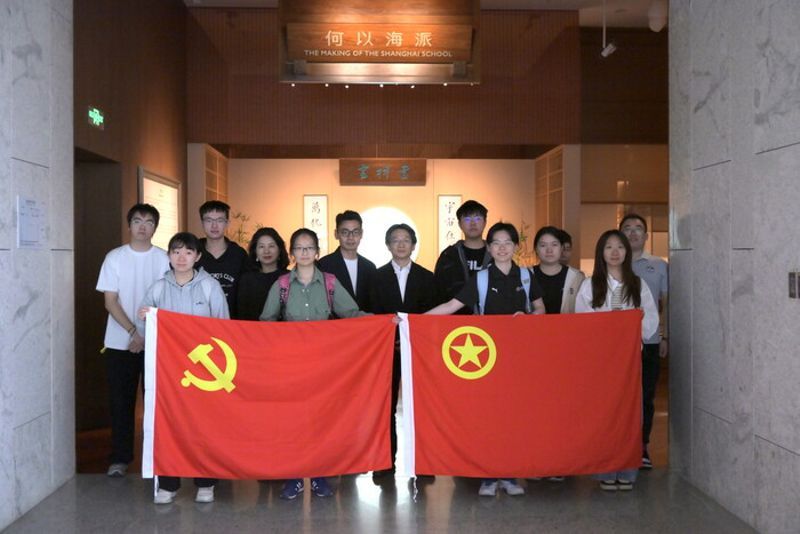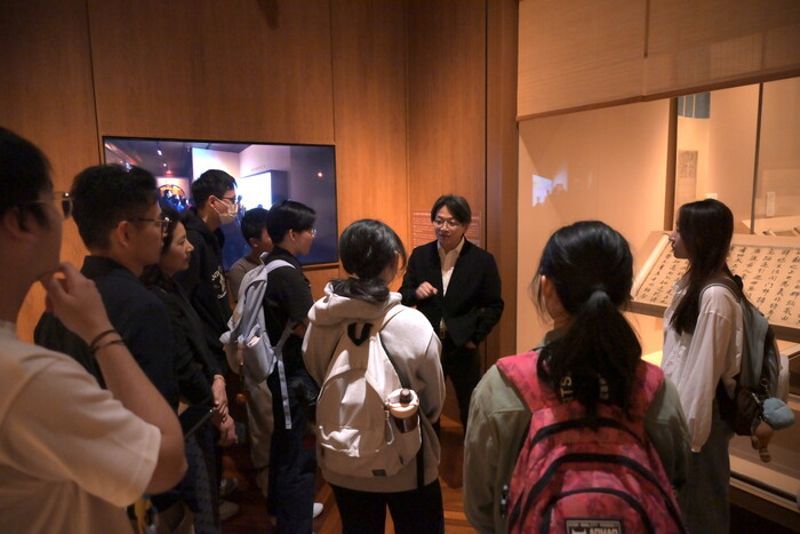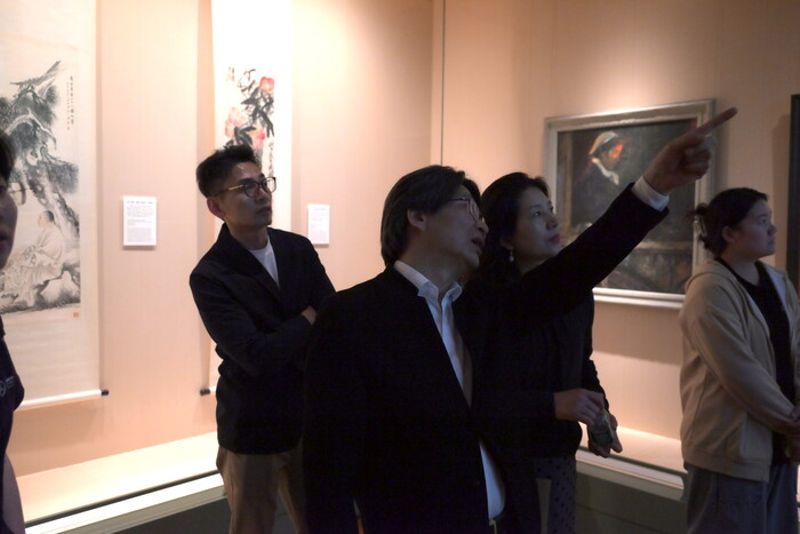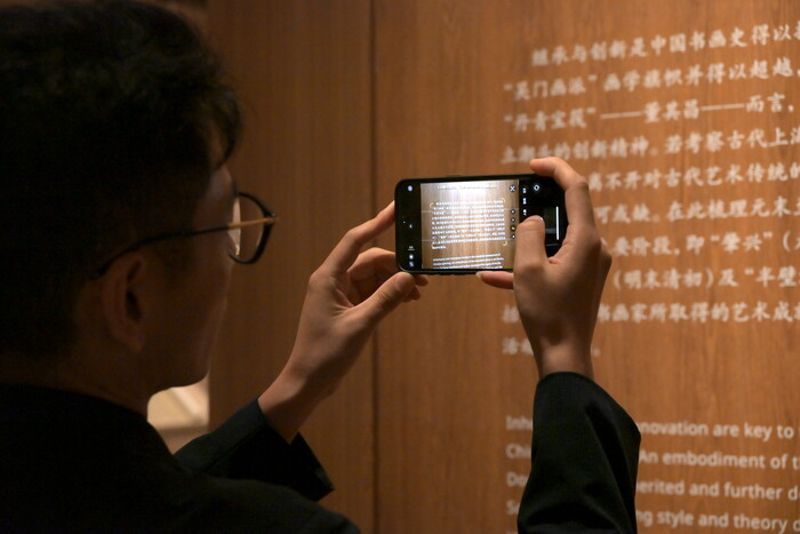On the afternoon of May 13, 2025, the Shanghai Painting and Calligraphy Exhibition Hall in the East Pavilion of the Shanghai Museum ushered in a special cultural journey. Representatives of teachers and students from the School of Marine Science and Engineering exclusively opened the Why Shanghai School immersive cultural party class on the closing day, followed by researcher Ling Lizhong, director of the Painting and Calligraphy Research Department of the Shanghai Museum and doctoral supervisor of the China Academy of Art, and opened an artistic dialogue spanning thousands of years with the treasures of calligraphy and painting from the Song, Yuan and modern dynasties as clues, and explored the spiritual code of Shanghai.
At the beginning of the event, Ling Lizhong took How much do you know about the history of Shanghai as a guide, and reconstructed the city's thousand-year-old cultural picture through the map of the changes of Shanghai's administrative regions in 1958 and the schematic map of calligraphy and painting in the past dynasties. From the Gu Garden on Dapu Road in Huangpu District in Wen Boren's Nanxi Thatched Cottage Map in the Ming Dynasty, to the ruins of Minhang Qushui Garden above Huangpu written by Wen Jia, the son of Wen Zhengming; From the scenery of Dianshan Lake in Qingpu depicted in Li Sheng's Farewell to Dianhu Lake in the Yuan Dynasty to the Gaochang Township in Pudong recorded in Yang Weizhen's Xingshu Zhenjing'an Recruiting Yuanshu Shujuan, the calligraphy and painting tell the historical context of various regions in Shanghai. Ling Lizhong pointed out in particular that Lu Ji's Pingfu Post in the Western Jin Dynasty, as the ancestor of the Fati and Dong Qichang's Songjiang practice of innovating literati painting, confirmed that the history of calligraphy and painting in Shanghai can be traced back to 1,700 years ago, and that it became the center of literati painting creation in the late Yuan Dynasty and early Ming Dynasty, giving birth to art giants who have influenced the history of Chinese painting for hundreds of years. Shanghai is by no means a small fishing village for 200 years, and Shanghai-style culture is not synonymous with concession culture, it is the crystallization of Jiangnan culture's thousand-year-old accumulation and open innovation.
In the process of combing through the thousand-year history of Shanghai's calligraphy and painting, Ling Lizhong revealed the profound relationship between art and urban spirit from an academic perspective. He summed up the humanistic core of Shanghai calligraphy and painting with the sixteen words of profound heritage, mellow artistic vein, inclusiveness, and courage to innovate: Lu Ji, Mi Fu to Dong Qichang, and Huang Binhong's artistic breakthroughs, showing the innovative courage in the inheritance; At the end of the Yuan Dynasty, the Songjiang literati collection synchronized with the changes of the Huangpu River water system, deducing the urban development logic of geography is destiny. The Yunjian School of Calligraphy in the Ming Dynasty laid the foundation of Wumen Qianyuan, and the modern Shanghai School of Painting created a new bureau of art transformation, highlighting the cultural genes of inclusiveness. Through the ancient rhyme of Jinshan Zhangyan in Zhuxi Thatched Cottage and the modern style of Sheshan in Nine Peaks Zhaoyin, Ling Lizhong vividly explains how calligraphy and painting cultural relics can become the key to decoding the spirit of the city—they are not only artistic creations, but also carry Shanghai's history, economy, science and technology and humanistic interaction.
The party class deeply analyzed the internal relationship between Jiangnan culture, Shanghai culture and red culture. Ling Lizhong emphasized that the profound heritage of Jiangnan culture provides an eclectic soil for Shanghai-style culture, and the collision between China and the West has given birth to the spirit of the times of openness and innovation, and red culture is rooted in this sublimation. From the two lands in the clouds in the Western Jin Dynasty to the three peaks since the Song and Yuan dynasties, the history of physical evidence enriches the narration of Shanghai's human history. The history of calligraphy and painting in Shanghai is the epitome of the city's spiritual character.
As the highlight of the Appreciation of Maritime Art section of the 2025 Shanghai Cultural Experience Month, this event broke down professional barriers and helped teachers and students better understand the urban spirit and traditional humanistic background of Shanghai, an international metropolis, as well as the urban spirit of openness, inclusiveness and innovation. It not only allows the students to appreciate the thousand-year-old context of Chinese painting and calligraphy, but also stimulates interdisciplinary thinking through the innovative genes of Shanghai-style art, so that the excellent traditional Chinese culture can become the source of nourishing modern scientific and technological innovation, and contribute to the brand building of Shanghai Culture and the enhancement of the city's cultural soft power.

Figure 1 Group photo

Figure 2 Immersion Cultural Party Class

Figure 3 Immersion Culture Party Class

Figure 4 Immersion Culture Party Class

Figure 5 Immersion Culture Party Class
